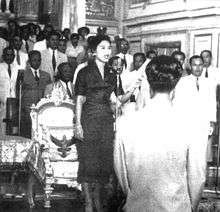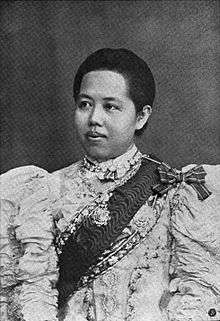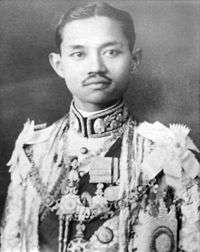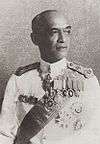Regent of Thailand

In Thailand, the regent (Thai: ผู้สำเร็จราชการแทนพระองค์) is a person who exercises the official functions of a monarch of Thailand when the monarch is incapable of functioning or during a period of interregnum.
Appointment
According to the constitution of Thailand 2007, there will be a regent when the monarch is unable to function or when there is no monarch.
Incapacity of monarch

In pursuance of the 2007 constitution, if the monarch is to leave the country or is unable to perform his duties for whatever reason, he can appoint any specific person as his regent and the president of the National Assembly of Thailand will countersign the appointment.[1]
But if the monarch does not appoint any regent or cannot make the appointment due to his minority or for any other reason, the Privy Council of Thailand will nominate an appropriate person to the National Assembly. Once approved by the National Assembly, the president of the National Assembly will, in the name of the monarch, appoint that person as the regent.[2]
Until a regent is appointed by the monarch or the National Assembly, the president of the Privy Council will serve as the regent ad interim.[3]
The constitution also requires an appointed regent to take the following oath of office amongst the National Assembly before assuming office:[4]
“ I, (name of the regent), do hereby declare that I will be loyal to His Majesty King (the king's name), and will faithfully carry out my duties in the interest of the nation and her people, and will also uphold and observe the Constitution of the Kingdom of Thailand in all sincerity. ”
Interregnum
In accordance with the 2007 constitution, when the throne becomes vacant, the president of the Privy Council of Thailand will act as the regent ad interim until a monarch is installed.[5]
But if the vacancy takes place when there was already a regent, appointed by the previous monarch or the National Assembly due to the monarch's incapacity, that regent will continue to function until a monarch is enthroned.[5] If the appointed regent is unable to function, the president of the Privy Council will also serve as the regent ad interim.[6]
Flag
The regent is given a official flag by the Flag Act 1979. It is a white square flag with a shield of the national flag at the centre, topped by the mythological bird garuda, which is the national emblem of Thailand.[7]
List of regents of Thailand
Fifth Reign
| Portrait | Name | Date of Appointment | Ceased to be Regent | Note |
|---|---|---|---|---|
| King Chulalongkorn (Rama V) | ||||
| Somdet Chao Phraya Borom Maha Si Suriyawong (Chuang Bunnag) |
Late 1868 | 16 November 1873 | Appointed regent by the Council of Ministers, until the king reached his majority at the age of 20. | |
 |
Queen Saovabha Phongsri | 7 April 1897[8] | 16 December 1897 | Appointed regent for the duration of the king's first visit to Europe. After the king's return title was elevated to Queen Regent. |
 |
Crown Prince Maha Vajiravudh |
27 March 1907 | 17 November 1907 | Appointed regent for the duration of the king's second visit to Europe. |
Sixth Reign
| Portrait | Name | Date of Appointment | Ceased to be Regent | Note |
|---|---|---|---|---|
| King Vajiravudh (Rama VI) | ||||
 |
Prince Prajadhipok Sakdidej, the Prince of Sukhothai |
1925 | 25 November 1925 | Appointed regent during the illness of the king, after the king's death on 25 November 1925, himself succeeded to the throne as King Rama VII. |
Seventh Reign
| Portrait | Name | Date of Appointment | Ceased to be Regent | Note |
|---|---|---|---|---|
| King Prajadhipok (Rama VII) | ||||
 |
Prince Paribatra Sukhumbhand, the Prince of Nakhon Sawan |
9 April 1932 | 8 May 1932 | Appointed regent for the duration of the king's summer holiday in Hua Hin, Prachuap Khiri Khan Province. |
 |
Prince Chitcharoen, the Prince Narisara Nuvadtivongs |
12 January 1934[9] | 2 March 1935 | Appointed regent while the king visited Europe for medical treatment, regency ended with the king's abdication of the throne. |
Eight Reign
| Portrait | Name | Date of Appointment | Ceased to be Regent | Note |
|---|---|---|---|---|
| King Ananda Mahidol (Rama VIII) | ||||
 |
Prince Oscar Anuvatana | 2 March 1935[10] | 12 August 1936 | Appointed president of the three members regency council, during the king's minority (10 years of age at the time) and absence, as he was living in Switzerland. Died in office (committed suicide). |
 |
Prince Athitaya Dibhabha | 31 July 1944 | Succeeded Prince Oscar as president. Later resigned from office and ceased to be regent, died in 1945.[11] | |
.jpg) |
Chao Phraya Yomarath (Pan Sukhum) |
30 December 1938 | Died in office | |
 |
Chao Phraya Bijayendra Yodhin (General Um Indrayodhin) |
21 August 1935[12] | 21 July 1942 | Appointed regent to replace Prince Oscar. Died in office. |
 |
Luang Praditmanutham (Dr. Pridi Banomyong) |
16 December 1941[13] | 20 September 1945 | Appointed regent to replace Chao Phraya Yomarath, previously held office as Minister of Finance. After the resignation of Prince Athitaya became the sole regent, until the return of the king in 1946.[11] Later became the 7th prime minister of Thailand in 1946. |
Ninth Reign
| Portrait | Name | Date of Appointment | Ceased to be Regent | Note |
|---|---|---|---|---|
| King Bhumibol Adulyadej (Rama IX) | ||||
 |
Prince Rangsit Prayurasakdi, the Prince of Chainat |
16 June 1946[14] | 7 November 1947 | Appointed two person regency council, when the king decided to return to his studies at the University of Lausanne in Switzerland. |
 |
Phraya Manovaratsevi (Plod Vichear na Songkhla) | |||
 |
Regency under the Privy Council | 9 November 1947[15] | 23 January 1949 | After the Siamese coup d'état of 1947 a new Privy Council was created and was given the power of regency under the Temporary Constitution of 1947. The council was composed of: 1. Prince Rangsit Prayurasakdi, the Prince of Chainat 2. Prince Dhanivat, the Prince Bidyalabh Bridhyakon 3. Prince Alongkorn, the Prince Adireksorn Udomsakdi 4. Phraya Manovaratsevi (Plod Vichear na Songkhla) 5. General Adul Adulyadejchrat (Bhat Peungprakhun) The council was relieved of the regency with the promulgation of the 1949 Constitution. |
 |
Prince Rangsit Prayurasakdi, the Prince of Chainat |
23 June 1949[16] | Late 1949 | Appointed sole regent by recommendation of the National Assembly. Regency ended when the king returned to Thailand to be crowned on 5 May 1950. |
| 5 June 1950[17] | 7 March 1951 | Appointed regent during the king's travel and stay in Switzerland. Died in Office. | ||
 |
Prince Dhanivat, the Prince Bidyalabh Bridhyakon |
20 March 1951[18] | 19 December 1952 | Replace Prince Rangsit as regent. Regency ends after the king's permanent return to Thailand. |
 |
Queen Sirikit of Thailand | 22 October 1956[19] | 5 November 1956 | Appointed regent during the king's absence as a Bhikkhu monk in the Buddhist Sangha (at Wat Bowonniwet Vihara). Afterwards title elevated to Queen Regent. |
 |
Princess Srisangwan, the Princess Mother of Thailand | 18 December 1959[20] | 21 December 1959 | State visit to the Republic of Vietnam by the king and queen. |
| 9 February 1960[21] | 16 February 1960 | State visit to the Republic of Indonesia by the king and queen. | ||
| 2 March 1960[22] | 5 March 1960 | State visit to the Union of Burma by the king and queen. | ||
| 14 June 1960[23] | 1960 | State visit to the United States of America and European countries by the king and queen. | ||
| 11 March 1962[24] | 22 March 1962 | State visit to the Islamic Republic of Pakistan by the king and queen. | ||
| 20 June 1962[25] | 27 June 1962 | State visit to the Federation of Malaya by the king and queen. | ||
| 17 August 1962[26] | 13 September 1962 | State visit to New Zealand and Australia by the king and queen. | ||
 |
Prince Dhanivat, the Prince Bidyalabh Bridhyakon (President of the Privy Council) |
27 May 1963[27] | 6 June 1963 | State visit to Japan and Republic of China by the king and queen. |
| 9 July 1963[28] | 14 July 1963 | State visit to the Philippines by the king and queen. | ||
 |
Princess Srisangwan, the Princess Mother of Thailand | 12 September 1964[29] | 6 October 1964 | Visit to the Kingdom of Greece on the occasion of the marriage of King Constantine II and Anne-Marie of Denmark and the state visit to the Republic of Austria by the king and queen. |
| 15 July 1966[30] | 1966 | State visit to the United Kingdom by the king and queen. | ||
| 23 April 1967[31] | 30 April 1967 | State visit to the Imperial State of Iran by the king and queen. | ||
| 6 June 1967[32] | 1967 | State visit to the United States of America and Canada by the king and queen. | ||
Tenth Reign
| Portrait | Name | Date of commencement | Ceased to be Regent | Note |
|---|---|---|---|---|
| King Vajiralongkorn (Rama X) | ||||
.jpg) |
General Prem Tinsulanonda (President of the Privy Council) |
13 October 2016 | 1 December 2016 | Became regent pro tempore upon the death of King Bhumibol Adulyadej. Tenure ended when Vajiralongkorn accepted invitation to ascend the throne.[33] |
See also
| Wikimedia Commons has media related to Regents of Thailand. |
- Monarchy of Thailand
- List of Thai Monarchs
- List of Thai royal consorts
- Crown Prince of Thailand
- Regent
- List of regents
- Constitution of Thailand
References
- ↑ "Ratthathammanūn hæng rātcha'ānāčhak thai phutthasakkarāt sǭng phan hā rǭi hā sip" รัฐธรรมนูญแห่งราชอาณาจักรไทย พุทธศักรา ๒๕๕๐ [Constitution of the Kingdom of Thailand 2007] (in Thai). Bangkok: Office of the Council of State of Thailand. 2014-03-27. Retrieved 2016-10-12.
มาตรา ๑๘ ในเมื่อพระมหากษัตริย์จะไม่ประทับอยู่ในราชอาณาจักร หรือจะทรงบริหารพระราชภาระไม่ได้ด้วยเหตุใดก็ตาม จะได้ทรงแต่งตั้งผู้ใดผู้หนึ่งเป็นผู้สำเร็จราชการแทนพระองค์ และให้ประธานรัฐสภาเป็นผู้ลงนามรับสนองพระบรมราชโองการ
- ↑ "Ratthathammanūn hæng rātcha'ānāčhak thai phutthasakkarāt sǭng phan hā rǭi hā sip" รัฐธรรมนูญแห่งราชอาณาจักรไทย พุทธศักรา ๒๕๕๐ [Constitution of the Kingdom of Thailand 2007] (in Thai). Bangkok: Office of the Council of State of Thailand. 2014-03-27. Retrieved 2016-10-12.
มาตรา ๑๙ ในกรณีที่พระมหากษัตริย์มิได้ทรงแต่งตั้งผู้สำเร็จราชการแทนพระองค์ตามมาตรา ๑๘ หรือในกรณีที่พระมหากษัตริย์ไม่สามารถทรงแต่งตั้งผู้สำเร็จราชการแทนพระองค์เพราะยังไม่ทรงบรรลุนิติภาวะหรือเพราะเหตุอื่น ให้คณะองคมนตรีเสนอชื่อผู้ใดผู้หนึ่งซึ่งสมควรดำรงตำแหน่งผู้สำเร็จราชการแทนพระองค์ต่อรัฐสภาเพื่อขอความเห็นชอบ เมื่อรัฐสภาให้ความเห็นชอบแล้วให้ประธานรัฐสภาประกาศในพระปรมาภิไธยพระมหากษัตริย์ แต่งตั้งผู้นั้นเป็นผู้สำเร็จราชการแทนพระองค์...
- ↑ "Ratthathammanūn hæng rātcha'ānāčhak thai phutthasakkarāt sǭng phan hā rǭi hā sip" รัฐธรรมนูญแห่งราชอาณาจักรไทย พุทธศักรา ๒๕๕๐ [Constitution of the Kingdom of Thailand 2007] (in Thai). Bangkok: Office of the Council of State of Thailand. 2014-03-27. Retrieved 2016-10-12.
มาตรา ๒๐ ในระหว่างที่ไม่มีผู้สำเร็จราชการแทนพระองค์ตามที่บัญญัติไว้ในมาตรา ๑๘ หรือมาตรา ๑๙ ให้ประธานองคมนตรีเป็นผู้สำเร็จราชการแทนพระองค์เป็นการชั่วคราวไปพลางก่อน...
- ↑ "Ratthathammanūn hæng rātcha'ānāčhak thai phutthasakkarāt sǭng phan hā rǭi hā sip" รัฐธรรมนูญแห่งราชอาณาจักรไทย พุทธศักรา ๒๕๕๐ [Constitution of the Kingdom of Thailand 2007] (in Thai). Bangkok: Office of the Council of State of Thailand. 2014-03-27. Retrieved 2016-10-12.
มาตรา ๒๑ ก่อนเข้ารับหน้าที่ ผู้สำเร็จราชการแทนพระองค์ซึ่งได้รับการแต่งตั้งตามมาตรา ๑๘ หรือมาตรา ๑๙ ต้องปฏิญาณตนในที่ประชุมรัฐสภาด้วยถ้อยคำ ดังต่อไปนี้ 'ข้าพเจ้า (ชื่อผู้ปฏิญาณ) ขอปฏิญาณว่า ข้าพเจ้าจะจงรักภักดีต่อพระมหากษัตริย์ (พระปรมาภิไธย) และจะปฏิบัติหน้าที่ด้วยความซื่อสัตย์สุจริต เพื่อประโยชน์ของประเทศและประชาชน ทั้งจะรักษาไว้และปฏิบัติตามซึ่งรัฐธรรมนูญแห่งราชอาณาจักรไทยทุกประการ'...
- 1 2 "Ratthathammanūn hæng rātcha'ānāčhak thai phutthasakkarāt sǭng phan hā rǭi hā sip" รัฐธรรมนูญแห่งราชอาณาจักรไทย พุทธศักรา ๒๕๕๐ [Constitution of the Kingdom of Thailand 2007] (in Thai). Bangkok: Office of the Council of State of Thailand. 2014-03-27. Retrieved 2016-10-12.
มาตรา ๒๔ ในระหว่างที่ยังไม่มีประกาศอัญเชิญองค์พระรัชทายาทหรือองค์ผู้สืบราชสันตติวงศ์ขึ้นทรงราชย์เป็นพระมหากษัตริย์ตามมาตรา ๒๓ ให้ประธานองคมนตรีเป็นผู้สำเร็จราชการแทนพระองค์เป็นการชั่วคราวไปพลางก่อน แต่ในกรณีที่ราชบัลลังก์ว่างลงในระหว่างที่ได้แต่งตั้งผู้สำเร็จราชการแทนพระองค์ไว้ตามมาตรา ๑๘ หรือมาตรา ๑๙ หรือระหว่างเวลาที่ประธานองคมนตรีเป็นผู้สำเร็จราชการแทนพระองค์ตามมาตรา ๒๐ วรรคหนึ่ง ให้ผู้สำเร็จราชการแทนพระองค์นั้น ๆ แล้วแต่กรณี เป็นผู้สำเร็จราชการแทนพระองค์ต่อไป ทั้งนี้ จนกว่าจะได้ประกาศอัญเชิญองค์พระรัชทายาทหรือองค์ผู้สืบราชสันตติวงศ์ขึ้นทรงราชย์เป็นพระมหากษัตริย์...
- ↑ "Ratthathammanūn hæng rātcha'ānāčhak thai phutthasakkarāt sǭng phan hā rǭi hā sip" รัฐธรรมนูญแห่งราชอาณาจักรไทย พุทธศักรา ๒๕๕๐ [Constitution of the Kingdom of Thailand 2007] (in Thai). Bangkok: Office of the Council of State of Thailand. 2014-03-27. Retrieved 2016-10-12.
มาตรา ๒๔...ในกรณีที่ผู้สำเร็จราชการแทนพระองค์ซึ่งได้รับการแต่งตั้งไว้และเป็นผู้สำเร็จราชการแทนพระองค์ต่อไปตามวรรคหนึ่งไม่สามารถปฏิบัติหน้าที่ได้ ให้ประธานองคมนตรีทำหน้าที่ผู้สำเร็จราชการแทนพระองค์เป็นการชั่วคราวไปพลางก่อน
- ↑ Office of the Council of State of Thailand (n.d.). "Unofficial translation: Flag Act, BE 2522 (1979)" (PDF). Bangkok: Office of the Council of State of Thailand. Retrieved 2016-10-12.
Section 43. Flags Showing Positions in General are: (1) Standard for the Regent of Thailand which is square shape with white field; in the middle of the flag, there is a yellow coat of arm with the width of 1 part out of 2 parts of the width of the flag; inside the yellow coat of arm, there is another coat of arm with the colours of the National Flag with the width of 3 parts out of 5 parts of the width of the yellow coat of arm; Above the coats of arm, there is a red garuda which is of the same size as the yellow coat of arm;...
- ↑ Royal Gazette, Royal Order on the Regent, Volume 13, Chapter 51, Page 599, 21 March 115 Rattanakosin Era
- ↑ Royal Gazette, Royal Command on the appointment of the Regent, Volume 50, Page 838, 11 January 2476 B.E.
- ↑ Royal Gazette, Announcement of the appointment of the Regency Council, Volume 41, Page 1332, 7 March 2477 B.E.
- 1 2 Royal Gazette, Appointment of Regent, Volume 61, Chapter 45, Page 730, 1 August 2487 B.E.
- ↑ Royal Gazette, Naming of a replacement to the Regency Council and the appointment of a new President, Volume 52, Page 1260, 21 August 2478 B.E.
- ↑ Royal Gazette, Naming of a replacement to the Regency Council, Volume 58, Page 1821, 16 December 2484 B.E.
- ↑ Royal Gazette, Announcement of the appointment of the Regency Council, Volume 63, Chapter 48, Page 240, 25 June 2489 B.E.
- ↑ Royal Gazette, Announcement on the appointment of the establishment of the Privy Council, Volume 64, Chapter 54, Page 688, 11 November 2490 B.E.
- ↑ Royal Gazette, Announcement on the appointment of the Regent, Volume 66, Chapter 34, Page 491, 28 June 2492 B.E.
- ↑ Royal Gazette, Announcement on the appointment of the Regent, Volume 67, Chapter 32, Page 645, 6 June 2493 B.E.
- ↑ Royal Gazette, Announcement on the appointment of the Regent, Volume 68, Chapter 18, Page 204, 20 March 2494 B.E.
- ↑ Royal Gazette, Announcement on the appointment of the Regent, Volume 76, Chapter 73, Page 1035, 25 September 2499 B.E.
- ↑ Royal Gazette, Announcement on the appointment of the Regent, Volume 76, Chapter 116, Page 12, 17 December 2502 B.E.
- ↑ Royal Gazette, Announcement on the appointment of the Regent, Volume 77, Chapter 10, Page 6, 4 February 2503 B.E.
- ↑ Royal Gazette, Announcement on the appointment of the Regent, Chapter 77, Chapter 16, Page 120, 1 March 2503 B.E.
- ↑ Royal Gazette, Announcement on the appointment of the Regent, Volume 77, Chapter 49, Page 26, 9 June 2503 B.E.
- ↑ Royal Gazette, Announcement on the appointment of the Regent, Volume 79, Chapter 23, Page 19, 8 March 2505 B.E.
- ↑ Royal Gazette, Announcement on the appointment of the Regent, Volume 79, Chapter 53, Page 9, 13 June 2505 B.E.
- ↑ Royal Gazette, Announcement on the appointment of the Regent, Volume 79, Chapter 74, Page 4, 16 August 2505 B.E.
- ↑ Royal Gazette, Announcement on the appointment of the Regent, Volume 80, Chapter 52, Page 25, 24 May 2506 B.E.
- ↑ Royal Gazette, Announcement on the appointment of the Regent, Volume 80, Chapter 69, Page 8, 8 July 2506 B.E.
- ↑ Royal Gazette, Announcement on the appointment of the Regent, Volume 81, Chapter 85, Page 614, 8 September 2507 B.E.
- ↑ Royal Gazette, Announcement on the appointment of the Regent, Volume 83, Chapter 57, Page 451, 5 July 2509 B.E.
- ↑ Royal Gazette, Announcement on the appointment of the Regent, Volume 84, Chapter 35, Page 1, 22 April 2510 B.E.
- ↑ Royal Gazette, Announcement on the appointment of the Regent, Volume 84, Chapter 49, Page 3, 1 June 2510 B.E.
- ↑ "Thai king death: Thousands throng streets for procession". BBC. 2016-10-14. Retrieved 2016-10-14.